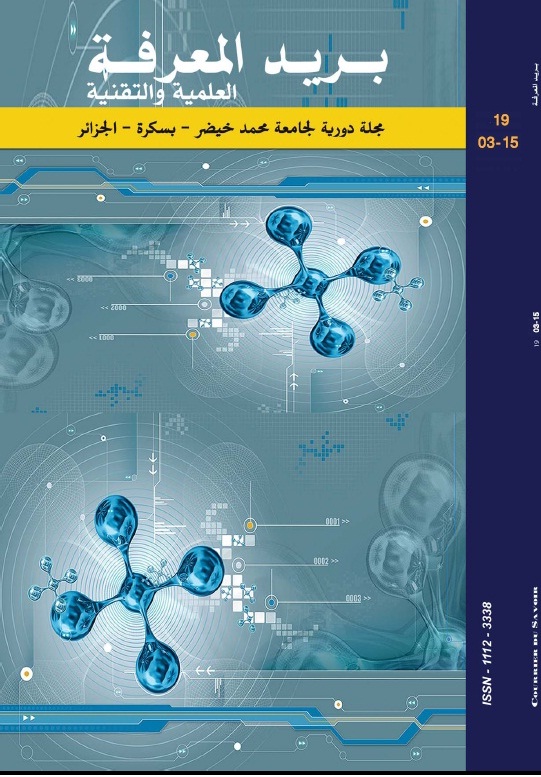EDAPHIC FACTORS AFFECTING DISTRIBUTION OF SOIL FUNGI IN THREE CHOTTS LOCATED IN ALGERIAN DESERT
Résumé
ABSTRACT
A total of 327 colonies of fungi were isolated from three chotts located in the Northeast of Algerian Sahara (Chott Merouane,
Melghir and Tighdidine). Twenty eight species representing thirteen genera were recorded in Chott Merouane, twenty two
species representing eleven genera were isolated from Chott Melghir and twenty five species corresponding to eleven genera
were recorded in Chott Tighdidine. The most common genera were Aspergillus, Penicillium and Cladosporium. Statistical
analysis revealed a significant positive correlation between fungal population and number of edaphic factors, especially
organic carbon and nitrogen contents. Fungal population showed negative correlation with chloride and sodium. The most
species isolated in this study were melanized fungi.
KEYWORDS: Fungi, distribution, hypersaline soil, edaphic factors.
RESUME
Trois cent vint sept colonies de champignons filamenteux sont isolées à partir de trois chotts localisés dans le Nord-est du
Sahara Algerien (Chott Merouane, Melghir and Tighdidine). Vingt-huit espèces de 13 genres ont été isolées de Chott
Merouane. Vingt-deux espèces de 11 genres ont été isolées de Chott Melghir et vingt-cinq espèces correspondant à 11 genres
ont été obtenues de Chott Tighdidine. Les genres les plus abondants sont Aspergillus, Penicillium et Cladosporium. L'analyse
statistique a révélé une corrélation positive significative entre la densité de la population fongique et un nombre des facteurs
édaphiques, en particulier la teneur en carbone organique et l’azote. La densité de la population fongique a montré une
corrélation négative avec la teneur de chlorure et de sodium.
MOTS CLES: Champignons filamenteux, distribution, sol hypersalin, facteurs édaphiques.
Références
(2007). Isolation and identification of soil mycoflora
of river induskotri, Pak. J. Bot., 39, 2663-2666.
[2] Satyanarayana, T., Chandralata R. Shivaji, S. (2005).
Extremophilic microbes: Diversity and perspectives.
Curr. Sci., 89, 78-90.
[3] Demnati, F., Allache, F. Ernoul, L Samraoui, B.
(2012). Socio-economic stakes and perceptions of
wetland management in an arid region: A case study
from Chott Merouane, Algeria. AMBIO., 41, 504-512.
[4] Mahowald, N. M., Bryant, R.G., Corral, J.
Steinberger, L. (2003). Ephemeral lakes and desert
dust sources. Geophys. Res. Let., 30, 46-49.
[5] Cantrell, S. A., Casillas-Martinez, L. Marirosa, M.
(2006). Characterization of fungi from hypersaline
environments of solar salterns using morphological
and molecular techniques. Mycol. Res., 110, 962-970.
[6] Boutaiba, S., Hacene, H., Bidle, K. A. Maupin-
Furiow, J.A. (2011). Microbial diversity of the
hypersaline Sidi Ameur and Himalatt salt lakes of the
Algerian Sahara. J. Arid. Environ., 75, 909-916.
[7] Aubert, G. (1978). Méthode d’analyse des sols.
CRDP., Marseille.
[8] Rodier, J. (2005). L’analyse de l’eau, Dunod, Paris.
[9] Davet, P. Rouxel, F. (1997). Détection et isolement
des champignons du sol. INRA., Paris.
[10] Botton, B., Breton, A., Fevre, M., Gauthier, S., et al.
(1990). Moisissures utiles et nuisibles importance
industrielle. Masson, Paris.
[11] Watanabe, T. (2002). Pictorial atlas of soil and seed
fungi: morphologies of cultured fungi and key to
species. Boca Raton. CRC Press.
[12] Demirel, R., Ilhan, S., Asan, A., Kinaci, E., Oner, S.
(2005). Microfungi in cultivated fields in Eskisehir
provience. J. Basic. Microbiol., 45, 279-293.
[13] Banakar, S. P., Thippeswamy, B., Thirumalesh, B. V.,
Naveenkumar, K. J. (2012). Diversity of soil fungi in
dry deciduous forest of Bhadra Wildlife Sanctuary,
western ghats of southern India. Journal of Forestry
Research, 23, 631-640.
[14] Abdel-Hafez, S. I. I. (1982). Thermophilic and
thermotolerant fungi in the desert soil of Saudi Arabia.
Mycopathologia, 80, 15-20.
[15] Abduallah, S. K., Al-khesraji, T.O. Al-edany, T.Y.
(1986). Soil mycoflora of the southern desert of Iraq.
Sydowia, 39, 8-16.
[16] Kanaujia, R.S., Singh, C. S. (1977). Studies on certain
ecological aspects of soil fungi, fungi in relation to
locality type, cover vegetation and physico-chemical
characters of the soil. Sydowia, 30, 112-121.
[17] Saravanakumar, K., Kaviyarasan, V. (2010). Seasonal
distribution of soil fungi and chemical properties of
montane wet temperate forest types of Tamil Nadu.
Afr. J. Plant Sci., 4, 190-196.
[18] Joshi, I.J. (1983). Investigations into the soil
mycoecology of chambal ravines of India. Plant Soil,
73, 177-186.
[19] Wu, N., Wang, H., Liang, S., Nie, H., Zhang, Y.
(2006). Temporal-spatial dynamics of distribution
patterns of microorganism relating to biological soil
crusts in the Gurbantunggut desert. Chinese Sci. Bull.,
51, 124-131.
[20] Joshi, I.J. and Chauhan, R. K. S. (1982). Distribution
of soil microfungi in various soil types of chambal
ravines. Proc. Indian natn. Sci. Acad., 48, 525-533.
[21] Aguilera, L. E. Gutierrez J. R. Meserve, P. L. (1999).
Variation in soil microorganisms and nutrients
underneath and outside the canopy of Adesmia bed
welli (papilionaceae) shrubs in arid coastal chile
following drought and above average rainfall. J. Arid.
Environ., 42, 61-70.
[22] Okoth, S.A., Odhiambo, J. (2009). Influence of soil
chemical and physical properties on Trichoderma spp.
occurrence in Taita region. Trop. subtrop.
agroecosyst., 11, 403-413.
[23] Grantina, L., Seile, E., Kenigsvalde, K., Kasparinskis,
R., Tabors, G. et al., (2011). The influence of the land
use on abundance and diversity of soil fungi:
comparison of conventional and molecular methods of
analysis. Environmental and Experimental Biology, 9,
9-21.
[24] Grishkan, I., Nevo, E., 2010. Spatiotemporal
distribution of soil microfungi in the Makhtesh Roman
area, central Negev desert, Israel. Fungal Ecol., 3,
326-337.
[25] Mandeel Q. A. (2002). Microfungal community
associated with rhizosphere soil of Zygophyllum
qatarense in arid habitats of Bahrain. J. Arid. Environ.,
50, 665-681.
[26] Carlile, M. J., Watkinson, S. C., Gooday, G. W.
(2001). The fungi, Academic press, London.


